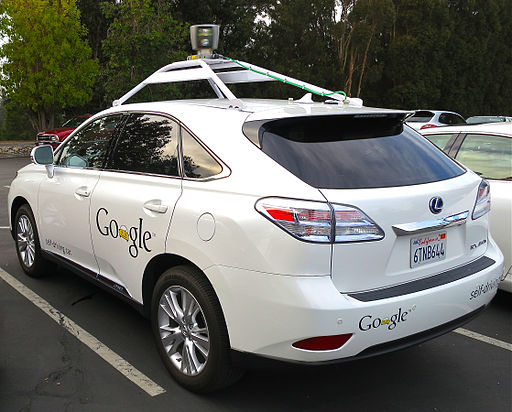The Future of Driverless Cars

Can we eliminate the high risks and dangers of texting while driving? Eliminate the driver behind the wheel. BMW, Mercedes-Benz, Nissan, General Motors, and Google are all involved in the autonomous driving and driverless vehicle phenom. The driverless technology is estimated to hit roads around 2020, explains TechnologyReview.com, which means in less than a decade, cars can drive — steer, brake, accelerate, and park — themselves.
Photo of Google’s driverless Lexus RX450h by Steve Jurvetson via Wikimedia Commons
Driverless Vehicle Carmakers
Google’s self-driving project had the Google Driverless Car in development for the past four years, and its Google Chauffeur software powers the autonomous cars. Google technologies include a lidar roof and camera that detects 3-D objects surrounding the vehicle, front and side radars, and an inertial measuring unit for position tracking.
BMW is also a prominent car maker joining this competitive market of technologically innovative cars. Werner Huber, who’s spearheading the BMW autonomous driving project, expressed to Technology Review that the BMW 5 Series is “the most impressive experience” BMW can offer. He elaborates and says the company hopes “to be ‘one of the first in the world’ to introduce highway autonomy.” The BMW 5 Series’ key technologies include a video camera for tracking lane markings and reading road signs, radar sensors for detecting objects and side laser scanners. In addition to advanced auto technologies, the driverless car provides the following advantages.
Crash Prevention, Car Sharing & Green Driving
Autonomous driving is not only alluring because of the idea of self-controlled driving robots, but because driverless cars eliminate human error. With less drivers on the road, roadways will experience fewer accidents and less traffic. Driverless system features can reduce the risk of crashes. U.S. auto insurer figures determine that forward collision warning systems help prevent crashes by warning the driver about a forthcoming collision or automatically braking the car.
Insurance Fraud Prevention
Auto insurance fraud is prevalent and driving up costs and fraud protection is as simple as removing the driver from the equation. U.S. safety regulators support the driverless vehicles because of the systems’ ability to predict and avoid traffic accidents. By eliminating human error and crashes on the road, auto insurance coverage can lower. These automated systems are also powered by innovative technologies that can detect signs of fraud, which mitigates problematic insurance fraud.
Not only do futuristic automated cars help mitigate human error, the vehicles can decrease fuel consumption and reduce pollution. Autonomous roadways and highways support a shared economy, which also helps lower gas consumption and pollution as fewer cars occupy roads. Forbes describes the driverless car as the vehicle to influence shared fleets in a community. Cars would be used on an “as-needed” basis. A car sharing system would include dropping off a car at a central location for another driver to pick up who registered on their smartphone.
Don’t forget to joined our community on Facebook, Twitter, and YouTube. Thanks






